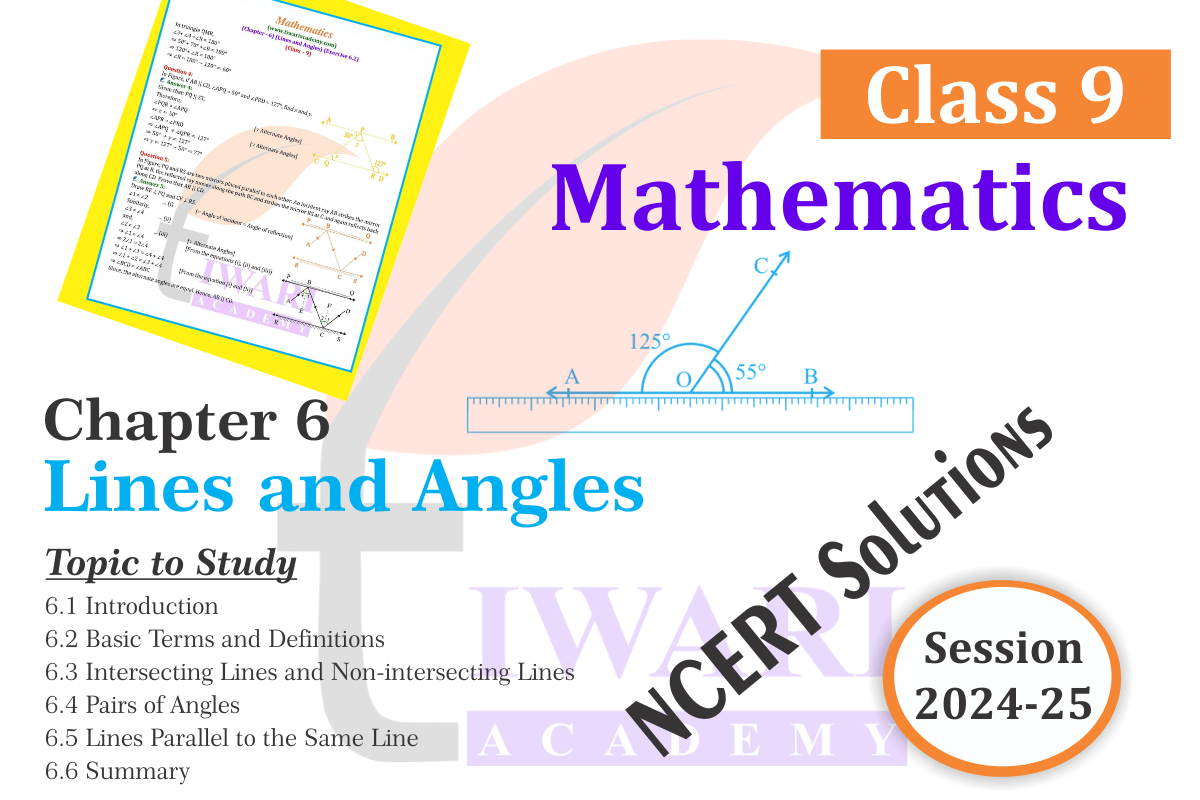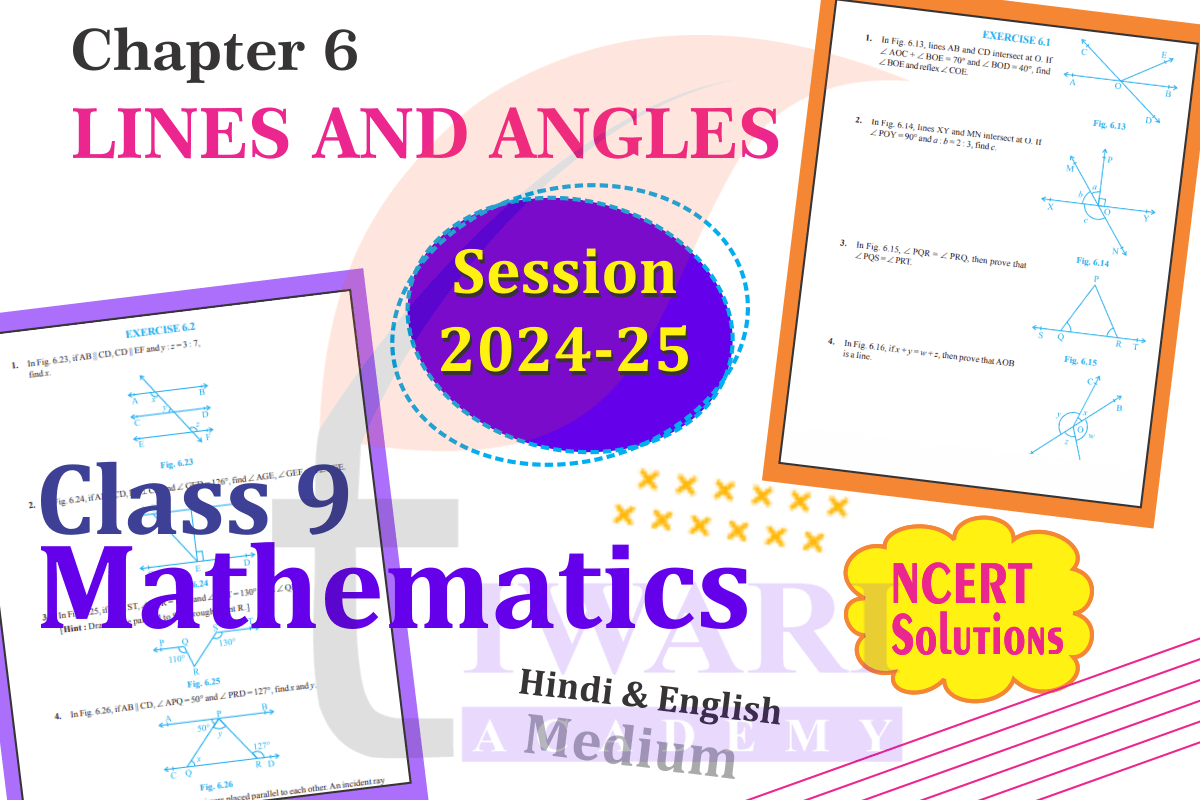NCERT Solutions for Class 9 Maths Chapter 6 Lines and Angles in English and Hindi Medium updated for academic session 2025-26. NCERT Textbook Solutions for Class 9 Mathematics Chapter 6 Lines and Angles are essential for students to strengthen their understanding of this critical topic. NCERT Grade 9th Math chapter 6 focuses on the properties and relationships of Geometrical lines, angles forming and the concepts of parallel and intersecting lines. NCERT Class 9th Maths Chapter 6 Topics Solutions provide step-by-step explanations for all the exercises, ensuring clarity in concepts.
Class 9 Maths Chapter 6 Solutions: CBSE Board
With Lines and Angles Class 9 NCERT Math Solutions, students can practice problem-solving and gain confidence. Many students search for the Chapter 6 Maths NCERT Book Class 9 Solutions PDF to access solutions offline, making it easier to study on the go. The NCERT 9th Mathematics Chapter 6 Solutions include diagrams and proofs, which are crucial for board exam preparation. For a more comprehensive understanding, referring to Class 9 Math Exercise Chapter 6 Notes alongside the solutions is highly recommended. As per new syllabus there are only two exercises in 9th Maths chapter 6 which is given in new NCERT book for CBSE 2025-26.
Class 9 Maths Exercise 6.1 in English
Class 9 Maths Exercise 6.2 in English
For those preparing for CBSE exams, Lines and Angles NCERT Exercise Solutions Class 9 Mathematics are a reliable resource for understanding the fundamentals of geometry. NCERT Textbooks Class 9 Math Topic Chapter 6 Question Answers provided in these solutions are meticulously crafted to cover all the concepts in detail. Students often look for NCERT Detailed Solutions for Class 9 Maths PDF downloads to access high-quality materials easily. The Mathematics topic Lines and Angles Class 9 Exercise Solutions explain each step of solving problems from this chapter, ensuring conceptual clarity.
Class 9 Maths Chapter 6 Solutions: State Boards
To excel in exams, solving Class 9 Maths NCERT Book Chapter 6 Important Questions is vital as they give insights into frequently asked topics. The Class 9 Mathematics Chapter 6 Solution Guide offers additional problem-solving techniques and tricks to tackle complex questions. Students can also benefit from the NCERT Math Grade 9 Book Chapter 6 PDF Download, which provides concise explanations and exercises.
Class 9 Maths Chapter 6 Exercise 6.1
Class 9 Maths Chapter 6 Exercise 6.2
Class 9 Maths Chapter 6 Exercise 6.3
NCERT Solutions for Class 9 Maths Chapter 6
Lines and Angles in NCERT Class 9 Mathematics Solutions PDF ensures that students have access to all the materials they need to master this chapter. By practicing the NCERT Class 9 Maths Textbook Chapter 6 Exercises, students can test their understanding and improve their performance. CBSE Class 9 Exercise Math Chapter 6 Explanation in the solutions covers all theoretical and practical aspects, preparing students thoroughly for their CBSE exams. Many students find the Class 9 NCERT Math Book Chapter 6 Answer Key useful for verifying their answers and identifying areas of improvement. NCERT Mathematics Solutions for Class 9 Exercise Chapter 6 also include a detailed breakdown of each problem, making it easier to grasp difficult concepts.
Class 9 Maths Chapter 6 Solutions: Hindi Medium
Downloading the Lines and Angles NCERT Solutions PDF allows learners to study offline. With consistent practice using these materials, mastering and drawing Lines and calculating the degree of Angles in Mathematics Book Class 9 NCERT PDF becomes achievable for all students. Tiwari Academy typically provides detailed and comprehensive solutions to the Class 9 Maths NCERT textbook. These solutions break down complex mathematical concepts into simpler, step-by-step explanations, making it easier for students to understand and follow.
Class 9 Maths Exercise 6.1 in Hindi
Class 9 Maths Exercise 6.2 in Hindi
The solutions offered on Tiwari Academy website and app often focus on building a strong foundation of mathematical concepts. This can help students gain a clear understanding of the subject matter, which is crucial for success in mathematics.
Important Points in Class 9 Maths Chapter 6 for Board Exams
Angle Properties: Types of angles (acute, obtuse, etc.) and their relationships.
Parallel Lines: Properties and angles formed by transversal.
Intersecting Lines: Angle sum property of triangles.
Theorems: Proofs related to lines and angles.
Applications: Solving geometry problems effectively.
| Day | Topic | Tasks | Resources |
|---|---|---|---|
| Day 1 | Introduction to Lines and Angles | Read textbook, understand basic definitions | NCERT textbook, class notes |
| Day 2 | Parallel and Intersecting Lines | Practice examples, solve NCERT exercises | NCERT exercises, online videos |
| Day 3 | Angles Formed by Transversals | Work on diagrams, solve problems | Solution guides, geometry tools |
| Day 4 | Theorems and Proofs | Memorize theorems, attempt proofs | NCERT solutions, reference books |
| Day 5 | Revision and Mock Tests | Revise all topics, attempt mock questions | NCERT question bank, mock test papers |

| Class: 9 | Mathematics |
| Chapter 6: | Lines and Angles |
| Number of Exercises: | 2 (Two) |
| Content: | NCERT Exercises Solution |
| Mode of Content: | Images, Text, PDF and Videos |
| Academic Session: | CBSE 2025-26 |
| Medium: | English and Hindi Medium |
UP Board Solutions for Class 9 Maths Chapter 6 Prashnavali 6.1, and Prashnavali 6.2 of Rekhaen aur Kon in Hindi Medium are given below to free download in PDF file format. All the question answers are updated for academic year 2025-26. 9th Maths Solutions for Chapter 6 are compatible for UP Board and CBSE Board Students. The NCERT Solutions 2025-26 can be used in Video format by all the Boards like CBSE Board, MP Board, Gujrat, Board, UP Board and other board following NCERT (https://ncert.nic.in/) Books in the academic session 2025-26 onward. Chapter 6 of 9th Mathematics includes the concepts of Lines and Angles. It is the first chapter in Geometry in class 9 Maths, which takes time to understand the concepts.
Study Material for Class 9 Maths Chapter 6

Class 9 Maths Chapter 6 Practice Questions with Solution
What are Intersecting lines?
Intersecting lines: Two lines are said to be intersecting, if they intersect each other at one point.
What is meant by Parallel lines?
Parallel lines: Lines in the same plane which do not intersect when produced on either side.
What do you know about Transversal lines?
Transversal lines: It is a straight line which cuts two or more straight lines at distinct point.
What is an Acute angle?
Acute angle: An angle whose measure is less than 90 but more than 0.
What do you understand by an Obtuse angle?
Obtuse angle: An angle whose measure is more than 90 but less than 180.
What is a Right angle?
Right angle: An angle whose measure is 90.
What is the measure of a Straight angle?
Straight angle: The measure of a straight angle is 180.
What is Reflex angl?
Reflex angle: An angle whose measure is more than 180 but less than 360.
Which angle is called Complete angle?
Complete angle: An angle whose measure is 360.
What are Complementary angles?
Complementary angles: Two angles are said to be complementary, if the sum of their measure is 90.
What are Supplementary angles?
Supplementary angles: Two angles are said to be supplementary, if the sum of their measure is 180.
What are Adjacent angles?
Adjacent angles: Two angles are called adjacent angles, if they have a common vertex and common arm.
What do you know about Vertically opposite angles?
Vertically opposite angles: Two angles are said to be a pair of vertically opposite angles, if their arms from two pairs of opposite rays.
9th Maths Chapter 6 Solutions in English & Hindi Medium
NCERT Solutions for class 9 Maths Chapter 6 Exercise 6.1, and 6.2 Lines and angles in English Medium as well as Hindi Medium in PDF form as well as study online options are given for academic session 2025-26. UP Board or CBSE Board or other boards students can ask their doubts and reply to other users through Tiwari Academy Discussion Forum. A platform to share your knowledge.
Important Questions on 9th Maths Chapter 6
What are the different types of angle?
An acute angle measures between 0° and 90°, whereas a right angle is exactly equal to 90°. An angle greater than 90° but less than 180° is called an obtuse angle. A straight angle is equal to 180°. An angle which is greater than 180° but less than 360° is called a reflex angle. Further, two angles whose sum is 90° are called complementary angles, and two angles whose sum is 180° are called supplementary angles.
What is a line-segment?
A part (or portion) of a line with two end points is called a line-segment.
What is a ray?
A part of a line with one end point is called a ray.
What do you mean by collinear points or non-collinear points?
If three or more points lie on the same line, they are called collinear points; otherwise they are called non-collinear points.
What happens If a transversal intersects two parallel lines?
(i) each pair of corresponding angles is equal, (ii) each pair of alternate interior angles is equal, (iii) each pair of interior angles on the same side of the transversal is supplementary.
What is the sum of the three angles of a triangle?
The sum of the three angles of a triangle is 180°.
Important Notes on 9th Maths Chapter 6
If a transversal intersects two parallel lines, then
1. Each of the alternate interior angles is equal. (Converse is also true).
2. Each pair of interior angles on the same side of the transversal is supplementary. (Converse is also true).
3. Each pair of corresponding angles is equal.
Need of NCERT Solutions for Class 9 Maths Chapter 6 Lines and Angles
NCERT Updated Solutions for Class 9 Maths Chapter 6 Lines and Angles provide a comprehensive guide to solving all the exercises in this chapter. These solutions include step-by-step explanations, diagrams and proofs to help students understand concepts such as parallel and intersecting lines, angles formed by a transversal and their properties. The NCERT Textbook solutions are crafted to align with the NCERT syllabus, ensuring students are well-prepared for exams. Downloading the Class 9 Maths Chapter 6 Solutions PDF or referring to the Lines and Angles Class 9 NCERT Solutions is a great way to practice and excel in geometry.
Find Class 9 Maths Chapter 6 Important Questions
You can find Class 9 NCERT Maths Chapter 6 Important Questions in various study guides, online resources and NCERT solutions. These questions focus on frequently asked topics like the properties of angles and the relationships between parallel lines and transversal. Solving these questions enhances your understanding and helps you prepare for exams effectively. The NCERT Revised Solutions for Class 9 Maths PDF and the Lines and Angles Class 9 Exercise Solutions often include these important questions, ensuring students are exam-ready. Accessing resources such as the Class 9 Maths Chapter 6 Notes can further clarify concepts and improve problem-solving skills.
How can NCERT Class 9 Chapter 6 Solutions help in exams?
NCERT Mathematics Class 9 Chapter 6 Exercise Solutions are tailored to help students excel in exams by providing clear, accurate and detailed explanations for all exercises. These solutions are an essential tool for understanding key topics, such as angle properties and transversal relationships. The Class 9 NCERT Maths Textbook Chapter 6 Solution Guide helps students solve complex problems by breaking them down into simple steps. With resources like the Lines and Angles Class 9 Solutions PDF, students can practice offline and revise efficiently. Regular practice of NCERT Class 9 Maths Assignment Chapter 6 Exercises ensures students are well-prepared for their exams.
What are the uses of Lines and Angles chapter 6 of class 9th Maths in daily life?
Lines and angles are extremely important in many aspects of real life given below:
- Architect/Engineers use angle measurements to construct buildings, bridges, houses, monuments, etc.
- Carpenters use angle measuring devices such as protractors to make furniture like chairs, tables, beds, wooden, etc.
- We can see the angle in the clocks of our homes, made by hands of clocks. For example, if the small hand is in 3 and the big hand is in 12, we get a right angle.
- Athletes use angles to enhance their performance.
- Artists use their knowledge of angles to sketch portraits and paintings.
- Real-world examples of line/line segments are a pencil, a baseball bat, the cord to your cell phone charger, the edge of a table, etc.
- The line is an element of design and an essential part of many forms of art.
- Whenever an architect has to draw a plan for a multistoried building, she has to draw intersecting lines and parallel lines at different angles.
- To find the height of a tower or to find the distance of a ship from the light house, one needs to know the angle formed between the horizontal and the line of sight.
Why is downloading Lines and Angles Class 9 NCERT PDF useful?
Downloading the Lines and Angles Class 9 Maths NCERT PDF is useful because it provides easy access to all solutions and explanations for Chapter 6. It enables students to study offline, making it convenient to prepare for exams anytime. The PDF includes the NCERT Class 9 Maths Chapter 6 Explanation and the Class 9 Maths Chapter 6 Answer Key, which are helpful for verifying answers and clearing doubts. Students can use this resource to revisit important topics, practice exercises and strengthen their geometry skills. The Lines and Angles NCERT Book Solutions PDF ensures comprehensive learning and improved exam performance.
Which topic’s knowledge will students gain after completing chapter 6 of class 9th Maths?
After completing chapter 6 of class 9th Maths, students will gain the knowledge of the following topics:
- Basic terms and definitions (Line-segment, Ray, Collinear points, Non-collinear points, Angles, Arms, Vertex).
- Types of Angles (Acute angle, Obtuse angle, Straight angle, Right angle, Reflex angle).
- Meaning of Complementary, Supplementary Angles, Linear pair of angles, Vertically opposite angles.
- Intersecting Lines and Non-intersecting Lines.
- Parallel Lines and a Transversal.
- Lines which are parallel to the same line are parallel to each other.
- Angle sum property of a triangle.
What is the best way to study Class 9 Maths Chapter 6?
The best way to study NCERT Class 9 Maths Chapter 6 is to start by understanding the concepts in the NCERT textbook and then practicing exercises from the NCERT Revised Solutions for Class 9 Maths Chapter 6 Lines and Angles. Using the Class 9 Maths Chapter 6 Solution NCERT Guide helps simplify difficult problems and provides clarity on key topics. Regular practice of the Class 9 Mathematics Chapter 6 Important Questions sharpens your problem-solving skills. Downloading the NCERT Guide Class 9 Maths Chapter 6 PDF Download allows you to study offline and focus on areas that need improvement.
How many exercises, questions, and examples are there in chapter 6 (Lines and Angles) of class 9th mathematics?
There are three exercises in class 9 mathematics chapter 6 (Lines and Angles).
In the first exercise (Ex 6.1), there are six questions.
In the second exercise (Ex 6.2), there are six questions.
So, there are 12 questions in class 9 mathematics chapter 6 (Lines and Angles).
In this chapter, there are six examples also. Examples 1, 2, 3 are based on Ex 6.1, and examples 4, 5, 6 are based on Ex 6.2.
Which theorem can be asked in the school exam for proof from chapter 6 of class 9th Maths?
There are eight theorems in Chapter 6 Lines and Angles of class 9th Maths. All the theorems are important. The theorems whose proof can come in the school exam are:
- 1) Theorem 6.1 (If two lines intersect each other, then the vertically opposite angles are equal)
- 2) Theorem 6.6 (Lines which are parallel to the same line are parallel to each other)
- 3) Theorem 6.7 (Angle Sum Property of a Triangle).


